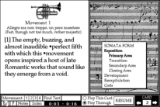
Beethoven's Ninth Symphony CD-ROM
Encyclopedia
Beethoven's Ninth Symphony CD-ROM was one of the first titles to couple a computer with an audio CD. This title was developed in 1989 by The Voyager Company in Apple Computer
's HyperCard
, using custom audio XCMDs developed at Voyager. The lead instructor and creative voice was UCLA music instructor Robert Winter.
Beethoven's Ninth Symphony, while offering black and white images on a 512x342 resolution display, offered full 44 kHz stereo audio by controlling an off-the-shelf audio CD in the CD-ROM
player.
Historically, Beethoven's Ninth Symphony is of importance as it was an early example of interactive media that reached the consumer market, before the popularization of the Internet
or DVD
s.
Apple Computer
Apple Inc. is an American multinational corporation that designs and markets consumer electronics, computer software, and personal computers. The company's best-known hardware products include the Macintosh line of computers, the iPod, the iPhone and the iPad...
's HyperCard
HyperCard
HyperCard is an application program created by Bill Atkinson for Apple Computer, Inc. that was among the first successful hypermedia systems before the World Wide Web. It combines database capabilities with a graphical, flexible, user-modifiable interface. HyperCard also features HyperTalk, written...
, using custom audio XCMDs developed at Voyager. The lead instructor and creative voice was UCLA music instructor Robert Winter.
Beethoven's Ninth Symphony, while offering black and white images on a 512x342 resolution display, offered full 44 kHz stereo audio by controlling an off-the-shelf audio CD in the CD-ROM
CD-ROM
A CD-ROM is a pre-pressed compact disc that contains data accessible to, but not writable by, a computer for data storage and music playback. The 1985 “Yellow Book” standard developed by Sony and Philips adapted the format to hold any form of binary data....
player.
Historically, Beethoven's Ninth Symphony is of importance as it was an early example of interactive media that reached the consumer market, before the popularization of the Internet
Internet
The Internet is a global system of interconnected computer networks that use the standard Internet protocol suite to serve billions of users worldwide...
or DVD
DVD
A DVD is an optical disc storage media format, invented and developed by Philips, Sony, Toshiba, and Panasonic in 1995. DVDs offer higher storage capacity than Compact Discs while having the same dimensions....
s.

